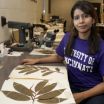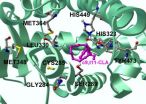(Press-News.org) The death of the American Chestnut due to an Asian bark fungus accidentally introduced to the United States had profound environmental and economic consequences since the tree was highly valued for its strong, workable lumber and a variety of wildlife from deer to birds to bears relied upon the chestnut for food.
Ongoing efforts to reintroduce the American Chestnut are labor intensive and expensive, in part because they rely on genetic cross breeding to produce a tree that is – genetically speaking – primarily an American Chestnut but endowed with the Chinese Chestnut blight-resistance genes. For instance, one recent blight-resistant strain ready for reintroduction is calculated to be 94 percent American Chestnut and six percent Chinese Chestnut.
Since production of genetically cross-bred American Chestnuts for reintroduction is so laborious, University of Cincinnati graduate and undergraduate biology students recently tested a new software tool called NEWGARDEN in order to see how it might guide preserve managers in creating the most-favorable conditions for reintroduction plantings of American Chestnuts.
The results of that testing, "Founder Placement and Gene Dispersal Affect Population Growth and Genetic Diversity in Restoration Planting of American Chestnut," will be presented by UC biology doctoral student Yamini Kashimshetty at the March 23-25 Midwest Ecology and Evolution Conference, a conference specifically for undergraduate and graduate student research that will draw representatives from the region.
Several years ago, UC faculty members Steven Rogstad of biological sciences and and Stephan Pelikan of mathematical sciences developed the NEWGARDEN computer program in order to not only track but to predict long-term outcomes for newly founded plant populations in terms of population size and genetic diversity.
Predicting best planting practices for American chestnuts
Using the NEWGARDEN software, UC students Kashimshetty and Melanie Simkins input a variety of founder planting scenarios in order to determine which would best promote a reintroduction population of American Chestnuts to thrive for the next 101 years.
They began with a theoretical restoration preserve of about 25 square kilometers square (or about 9.7 square miles). Using the software, they varied the original placement of 169 founder American Chestnuts to determine which pattern would theoretically lead to the largest population gains and the greatest genetic diversity among that population for the next 101 years. (An original replanting of 169 trees was selected for this study because previously published studies determined that figure to be the minimum number required to retain a high level of long-term genetic diversity while keeping reintroduction expenses at a minimum.)
Said Kashimshetty, "Due to the expense of producing the hybridized American Chestnuts, we wanted to test and determine potential best practices for reintroducing them. The tests that we are able to do virtually, such as varying different life history characteristics - including pollen and offspring-dispersal distances or varying the placement geometry of founders, cannot be easily done in the real world since large areas, large numbers of trees and replicate experiments lasting 100 years or more would be needed."
So, she added, "To perform multiple real-world variations on a tree like the American Chestnut would be extremely expensive and labor-intensive."
In testing varying reintroduction scenarios with the NEWGARDEN software, the UC team simulated natural population development and found
To ensure the greatest population growth rate and genetic diversity retention among the original founders and offspring trees, an original planting of a stand of 169 founders should be 1,500 meters (about 1,640 yards) into the preserve's borders. Said Kashimshetty, "If you plant near the edge of a preserve, you risk slower population growth and greater loss of genetic variation due to offspring dispersal out of the preserve."
By simply planting the founder trees 1,500 meters into the preserve and planting the original founder trees in a grid 16 feet apart from one another, the result in 101 years' time should be about 7,000 trees.
At least 9,000 resulting trees would be possible in 101 years' time by moderate dispersal (manually moving) of offspring seeds or seedlings to greater distances from the founders than would occur naturally.
If the original stand of trees is planted at the edge of the preserve, it's estimated that the original stand of 169 trees would result in approximately 2,000 resulting trees in 101 years' time. Thus, by planting the trees further into a preserve at 1,500 meters, with proper spacing, it's estimated that 247 percent more trees will result in 101 years' time.
Even planting the founder trees only 500 meters (1,640 feet) into the preserve vs. planting founders on the preserve's edge would increase the population size by 148 percent in 101 years' time.
Further, by planting the original founder trees just 500 meters into the preserve, 97 percent of their genetic diversity is preserved. Thus, if the goal is only to preserve genetic diversity without regard for achieving maximum population size, it's sufficient to plant the original stand 500 meters (1,640 feet) into the preserve.
Through such comparative computer modeling, the goal is to provide improved guidelines for the spacing and geometric patterning of founding trees in restoration plantings of American Chestnut, leading to a more successful return of this threatened but important native to the eastern forests of North America.
INFORMATION:
UC research tests new tool to guide reintroduction of the American chestnut
2012-03-20
ELSE PRESS RELEASES FROM THIS DATE:
Geoff Ficke to Be Interviewed on KSNX 105.5 AM The Believe Show on April 1st at 3:00pm MST
2012-03-20
Duquesa Marketing Founder and Expert to Discuss How to Create
Entrepreneurial Opportunities During a Tough Economy
Florence, KY Nancy Ficke, General Manager, announced today that her Branding and Product Development firm Duquesa Marketing has scheduled another in a series of national radio interviews for Company President and Founder Geoff Ficke.
"Geoff Ficke will appear on The Believe Show with Host Barbara Bruce April 1st at 3:00pm MST", said Mrs Ficke. "The discussion will be about the opportunity to take hold of your life and career options by ...
Genetic research develops tools for studying diseases, improving regenerative treatment
2012-03-20
MANHATTAN, KAN. -- Research from a Kansas State University professor may make it easier to recover after spinal cord injury or to study neurological disorders.
Mark Weiss, professor of anatomy and physiology, is researching genetic models for spinal cord injury or diseases such as Parkinson's disease. He is developing technology that can advance cellular therapy and regenerative medicine -- a type of research that can greatly improve animal and human health.
"We're trying to build tools, trying to build models that will have broad applications," Weiss said. "So if you're ...
Study reveals how monarch butterflies recolonize northern breeding range
2012-03-20
Each year, millions of monarch butterflies (Danaus plexippus) migrate from overwintering grounds in central Mexico to colonize eastern North America, but just how these delicate creatures manage to reach the northern part of their breeding range in spring has largely remained a mystery.
Monarch ButterflyNew research from the University of Guelph led by Prof. Ryan Norris, Department of Integrative Biology, former graduate student Nathan Miller and Environment Canada, reveals how monarchs recolonize the northern reaches of their breeding grounds — information that will ...
Trinity Digital Marketing Offering Free Website Design
2012-03-20
Trinity Digital Marketing has just released that they are running a rewards program. They are performing a free website design for an organization that is making the community a better place. This may include non-profits, churches, or various other organizations. You may visit their web design page at http://www.trinitydigitalmarketing.com/washington-dc-maryland-virginia-website-design.
If you have a business in the Washington DC, Maryland, or Virginia area that is making an impact, feel free to contact them. They have designed website carrying from businesses, political ...
A new tool to reveal structure of proteins
2012-03-20
COLUMBUS, Ohio – A new method to reveal the structure of proteins could help researchers understand biological molecules – both those involved in causing disease and those performing critical functions in healthy cells.
For roughly a decade, a technique called solid state nuclear magnetic resonance (NMR) spectroscopy has allowed researchers to detect the arrangements of atoms in proteins that defy study by traditional laboratory tools such as X-ray crystallography. But translating solid state NMR data into an actual 3D protein structures has always been difficult.
In ...
Step forward in research into new treatments for brain edema
2012-03-20
Cerebral edemas are accumulations of fluid into the intra- or extracellular spaces of the brain and it can result from several factors such as stroke or head trauma, among others.
Cerebral edema is a serious problem in neurology. While in other organs swelling does not lead to an urgent situation, in the brain it leads to coma and death. Although there are therapeutic solutions such as surgery, more effective treatments are needed.
Megalencephalic leukoencephalopathy with subcortical cysts (MLC) is a rare type of leukodystrophy (affects the white matter) of genetic ...
ArtistScope DRM for eBooks and PDF provides real security for authors
2012-03-20
ArtistScope DRM for the Digital Rights Management of both eBooks and PDF documents is now available and affordable for everyone to use. An author can be publishing fully protected documents within hours. Documents are not only protected from all manner of copying their content but are also protected from the copy and redistribution to others.
ArtistScope DRM is a total control solution comprised of a sophisticated suite of tools that enable authors to upload documents and images from a web page to be encrypted and assigned access rights permissions. The solution is unique ...
Global sea level likely to rise as much as 70 feet for future generations
2012-03-20
NEW BRUNSWICK, N.J. -- Even if humankind manages to limit global warming to 2 degrees C (3.6 degrees F), as the Intergovernmental Panel on Climate Change recommends, future generations will have to deal with sea levels 12 to 22 meters (40 to 70 feet) higher than at present, according to research published in the journal Geology.
The researchers, led by Kenneth G. Miller, professor of earth and planetary sciences in the School of Arts and Sciences at Rutgers University, reached their conclusion by studying rock and soil cores in Virginia, Eniwetok Atoll in the Pacific and ...
Researchers find that smoking may restore tapped-out self-control resources
2012-03-20
TAMPA, Fla. (March 19, 2012) – Researchers at Moffitt Cancer Center in Tampa, Fla., have found that when they deplete a smoker's self control, smoking a cigarette may restore self-control.
The study, published in a recent issue of the Journal of Abnormal Psychology (Vol. 121, No.1), exposed a test group and a control group – totaling 132 nicotine dependent smokers – to an emotional video depicting environmental damage. One group in the study expressed their natural emotional reactions (no depletion of self-control) while the second group suppressed their responses (self-control ...
Researchers discover novel therapy for Crohn's disease
2012-03-20
The Nutritional Immunology and Molecular Medicine Laboratory (NIMML) research team at Virginia Tech has discovered important new information on the efficacy of conjugated linoleic acid (CLA) in treating Crohn's disease, a form of inflammatory bowel disease (IBD). CLA is a naturally occurring acid found in meat and dairy products known for its anti-cancer and immune modulatory properties.
In collaboration with the Division of Gastroenterology and Hepathology at University of North Carolina School of Medicine and the Wake Forest Medical Center, researchers found that ...

